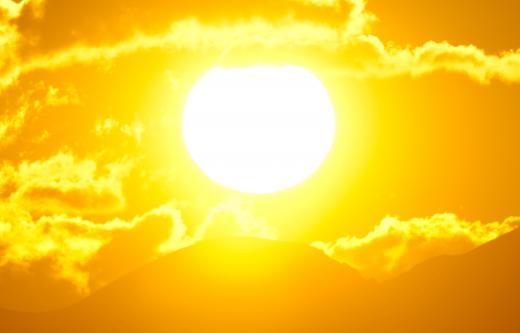What is the UV Spectrum?
When people refer to ultraviolet (UV) light, they usually mean the UV spectrum. A spectrum is a range of wavelengths rather than one specific wavelength. The UV spectrum is just one part of the entire electromagnetic (EM) spectrum; it is located just above visible light if the different categories were ranked according to energy. There are a number of subcategories of UV radiation, including near, middle, far, vacuum, and extreme. UV light is important for human health because it is a major source of vitamin D, but it can also increase health risks, such as skin cancer.
The electromagnetic spectrum is a system used to describe light of different wavelengths. Visible light is only one part of the spectrum, which runs from low energy radio waves to high energy gamma rays. The UV spectrum has a shorter wavelength, and higher frequency, than visible light and is higher energy. UV light isn’t only one part of a single wavelength, though; the UV spectrum ranges from a wavelength of around 10 nanometers (nm) to 400 nm.

This range of wavelengths is called ultraviolet because it is located just above the violet visible light section of the EM spectrum. Inside the UV spectrum, there are a number of further subsections. Near UV, for example, is closest to violet light, and includes radiation down to a wavelength of 315 nm. Extreme UV is at the other end of the spectrum, and contains radiation between 121nm and 10nm. The lower the wavelength, the higher the energy and frequency of the UV light.

Light within the UV spectrum is emitted by the sun. Sunlight contains UV radiation in a range of frequencies, which is why it must be referred to as a spectrum. UV consists of higher energy radiation than visible light, which is the reason why it can cause sunburn. Certain types of fluorescent lamps can also provide artificial UV radiation.
UV radiation can bring about both positive and negative health effects. Exposure to UV light is essential for the body to produce vitamin D, for example, a nutrient that is difficult to obtain from diet alone. UV light is also sometimes used to treat conditions of the skin, such as psoriasis, although this form of treatment must be monitored carefully to avoid damage. Many people also use UV radiation to get a more tanned appearance. Overexposure to this wavelength of light can cause skin cancer, however.
AS FEATURED ON:
AS FEATURED ON:













Discussion Comments
Yet another case for moderation! You need UV exposure but if you have too much UV exposure than it can lead to negative consequences.
My husband's mother was a smoker and now she has Chronic Obstructive Pulmonary Disease (COPD) and she has had it for so long she is not at the point where it is difficult for her to go anywhere outside and even indoor places if they have a strong smell.
For example we took her over to a friend's house and he had a candle burning. The smell and smoke were enough to cause her to become out of breath.
With her not being able to go outside I worried about her being on the other end of having too much UV exposure to not having enough UV exposure. When I mentioned this to her, she said she was taking a Vitamin D supplement, but I thought that it was still not enough to take the supplement that you still needed to get some sunlight.
Has anyone else heard this? And it also made me wonder - what happens to the vitamin D levels and overall health of people with agoraphobia (people who fear of leaving their house)?
Post your comments